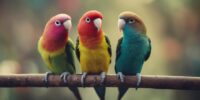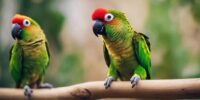How to Identify the Physical Characteristics Unique to Budgerigars (Budgies)
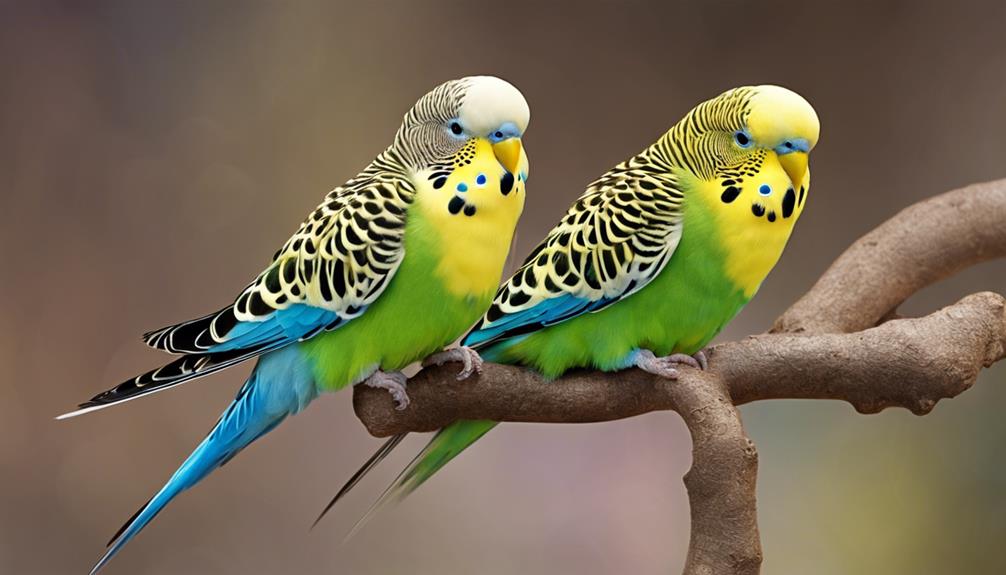
This species of parakeet is known for its vibrant plumage, which can include shades of green, yellow, blue, and white. The head and beak of a Budgerigar are typically smaller in proportion to their body size, with a slightly curved beak that is well-suited for cracking open seeds. Budgies also have long, slender wings that allow for swift flight and agile movement. Their tail is often long and tapered, providing balance during flight and perching. Additionally, Budgerigars are characterized by their round, expressive eyes that are usually dark in color.
These physical attributes combine to give Budgerigars their distinctive appearance, making them popular pets and beloved companions for bird enthusiasts around the world.
Budgerigar Size and Body Shape
Budgerigars, commonly known as budgies, exhibit variations in size and body shape that are key characteristics in distinguishing different breeds within the species. Budgerigar behavior traits play a significant role in understanding the needs of these birds. Budgies are highly social creatures and thrive in environments where they can interact with their human caregivers or other budgies. Providing them with plenty of toys, perches, and mental stimulation is essential for their well-being. Additionally, regular interaction and training can help develop a strong bond between the budgie and its owner.
When it comes to Budgie care tips related to size and body shape, it’s crucial to provide adequate space for these birds to move around freely within their enclosure. Different budgie breeds may vary in size, with some being smaller and more delicate than others. Understanding these differences can help tailor their care accordingly. Proper nutrition, including a balanced diet of seeds, fruits, and vegetables, is vital for maintaining their health and ensuring they’ve the energy to exhibit their natural behaviors.
Distinctive Feather Colors of Budgies

Budgerigars, commonly known as budgies, exhibit a fascinating array of colorful plumage patterns that vary from one individual to another. These distinctive feather colors can range from vibrant greens and yellows to striking blues and whites, creating a visually stunning display.
Additionally, rare mutation variations in budgie feather colors can result in unique and eye-catching combinations that make each bird truly one-of-a-kind.
Colorful Plumage Patterns
Colorful plumage patterns in budgerigars showcase a wide range of distinctive feather colors that play a significant role in their visual appeal and individual recognition. Budgies exhibit a spectrum of vibrant hues, including:
- Bright yellow
- Sky blue
- Olive green
- Pure white
- Deep violet
These colors are the result of breeding techniques and genetic inheritance, emphasizing the importance of maintaining a balanced diet to enhance plumage vibrancy and overall health.
Understanding the variations in feather colors can aid in identifying individual budgerigars and appreciating the beauty of these beloved birds.
Rare Mutation Variations
Rare mutation variations in budgies result in distinctive feather colors that diverge from the typical hues seen in the species. Genetic mutations play a crucial role in producing these avian rare traits, often influenced by selective breeding practices. By carefully selecting and breeding budgies with unique genetic variations, breeders can introduce new and exciting color patterns into the budgerigar population. Below is a table showcasing some of the rare mutation variations observed in budgies:
| Feather Color | Mutation Type | Description |
|---|---|---|
| Lutino | Ino gene mutation | Yellow body with red eyes |
| Clearwing | Clearwing mutation | Light body color with clear wing markings |
| Greygreen | Greywing mutation | Greyish-green body with light wing markings |
| Spangle | Spangle mutation | Distinctive pattern of spots and bars on body |
| Cinnamon | Cinnamon mutation | Warm brown body color with red eyes |
Recognizing Budgerigar Markings
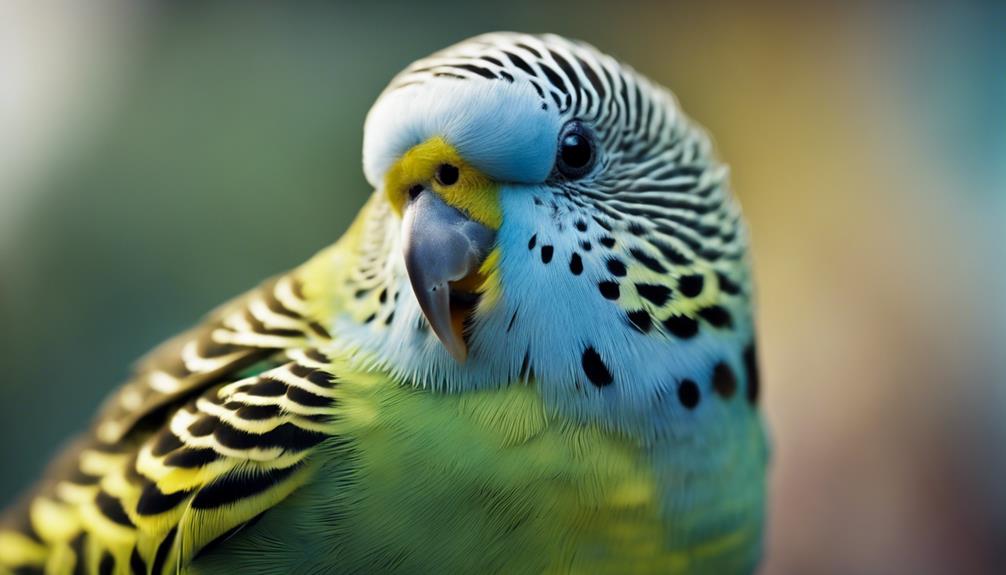
Distinctive patterns and shades on a budgerigar’s feathers help identify individual birds. Budgerigars exhibit a wide range of markings, each contributing to their unique appearance. When observing a budgerigar, it’s essential to pay attention to the following key markings:
- Wing Markings: Budgerigars often have distinct markings on their wings, such as wing spots or bars, which can vary in intensity and coloration.
- Face Markings: Some budgerigars display intricate markings around their face, including cheek patches and eye stripes, adding to their overall charm.
- Body Markings: The body of a budgerigar can showcase intricate patterns like scalloping or mottling, contributing to its individuality.
- Tail Markings: The tail feathers of a budgerigar may have unique patterns or coloration, aiding in identification.
- Throat Spots: These small spots located on the throat area can vary in size and shape, further distinguishing one budgerigar from another.
Budgerigar Head and Beak Features
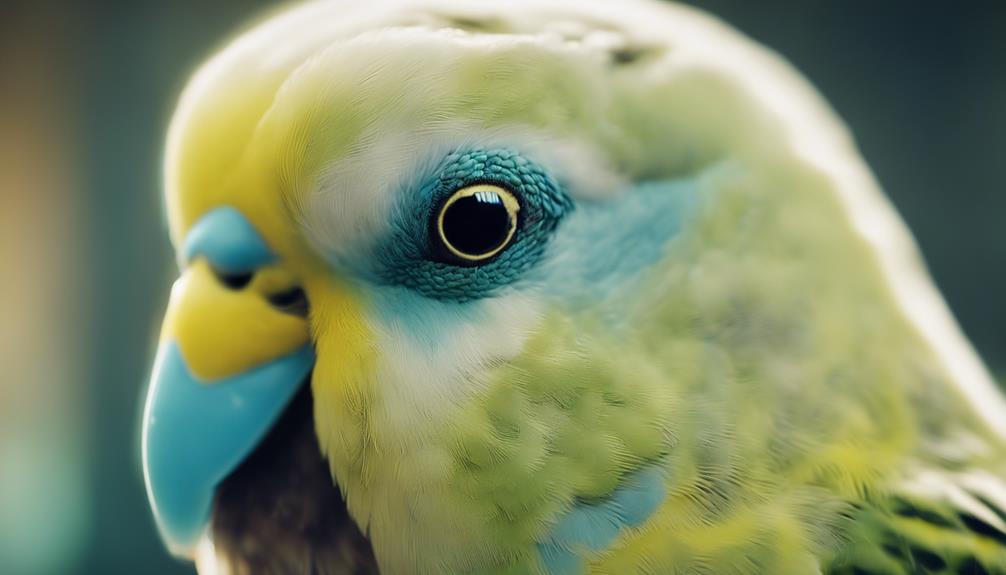
When examining a budgerigar, attention to the head and beak features provides valuable insight into the bird’s unique characteristics. The eye color of a budgerigar is a key identifier, typically ranging from dark brown to black in wild-type budgies, while captive-bred variants can display a variety of colors including white, red, or even violet.
The beak shape of a budgerigar is another distinguishing trait. Budgies have a strong, hooked beak ideal for cracking seeds, their primary food source in the wild. The upper and lower mandibles come together in a precise alignment, allowing for efficient seed husking. The beak’s shape also aids in climbing and manipulating objects in their environment.
Understanding the eye color and beak shape of budgerigars is crucial for accurately identifying these charming birds, whether in a pet or wild setting. By paying attention to these distinctive features, enthusiasts and researchers can better appreciate the beauty and adaptability of the budgerigar species.
Budgerigar Wing Characteristics
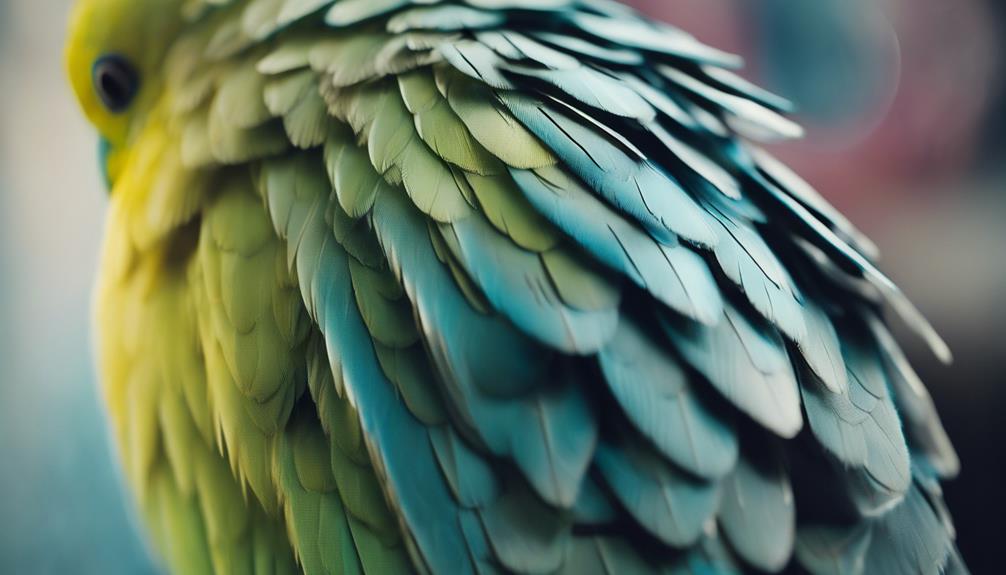
Budgerigar wing characteristics play a crucial role in avian identification. The arrangement of wing feathers, color patterns, and the shape and size of the wings are key factors to consider. These features provide valuable insights into the species and individual variations within the budgerigar population.
Wing Feathers Arrangement
Examining the arrangement of wing feathers in budgerigars reveals key characteristics unique to this species. These small parrots exhibit distinct features related to their wing feathers, shedding light on their natural behaviors and adaptations. When focusing on this aspect, it’s essential to consider:
- Feather molt patterns: Budgerigars follow specific molting schedules, replacing old feathers with new ones to maintain optimal flight capabilities.
- Wing grooming habits: These birds engage in meticulous grooming routines, ensuring their wing feathers are clean and well-maintained for efficient flight.
- Primary feather alignment: The alignment of primary feathers contributes to the aerodynamic efficiency crucial for budgerigars’ agile flight.
- Secondary feather distribution: The distribution of secondary feathers aids in controlling lift and stability during flight.
- Wing covert feather structure: The structure of wing covert feathers provides insulation and protection, supporting budgerigars in various environmental conditions.
Wing Color Patterns
With intricate variations in hue and intensity, wing color patterns in budgerigars serve as distinctive markers of individuality within the species. Budgerigars exhibit diverse wing color mutations, resulting in a range of hues from vibrant blues and greens to subtle yellows and whites.
These color variations can be influenced by factors such as diet and genetics. Wing feather growth is essential to maintaining these patterns, with new feathers often displaying more intense colors after molting.
The texture of wing feathers also plays a role in how colors are perceived, as smoother feathers may appear more vibrant compared to those with a rougher texture. Understanding these intricacies can aid in identifying and appreciating the unique wing color patterns of budgerigars.
Wing Shape and Size
Regularly observed in budgerigars, the wing shape and size play a crucial role in their overall aerodynamic capabilities and flight patterns. Budgerigar wings exhibit specific characteristics that contribute to their flight abilities:
- *Feather Texture:* Budgie wings have a smooth texture that aids in reducing air resistance during flight.
- *Wing Movement:* The wings of budgerigars allow for intricate movements, enabling them to execute swift turns and agile maneuvers in the air.
- *Wing Markings:* The markings on budgerigar wings can vary between different color mutations and may serve as identifiers for individual birds.
- *Flight Patterns:* The size and shape of the wings influence the flight patterns of budgerigars, affecting their speed and agility in the air.
- *Aerodynamic Design:* The streamlined shape of their wings enhances efficiency during flight, helping them navigate their environment with precision.
Budgerigar Tail Structure
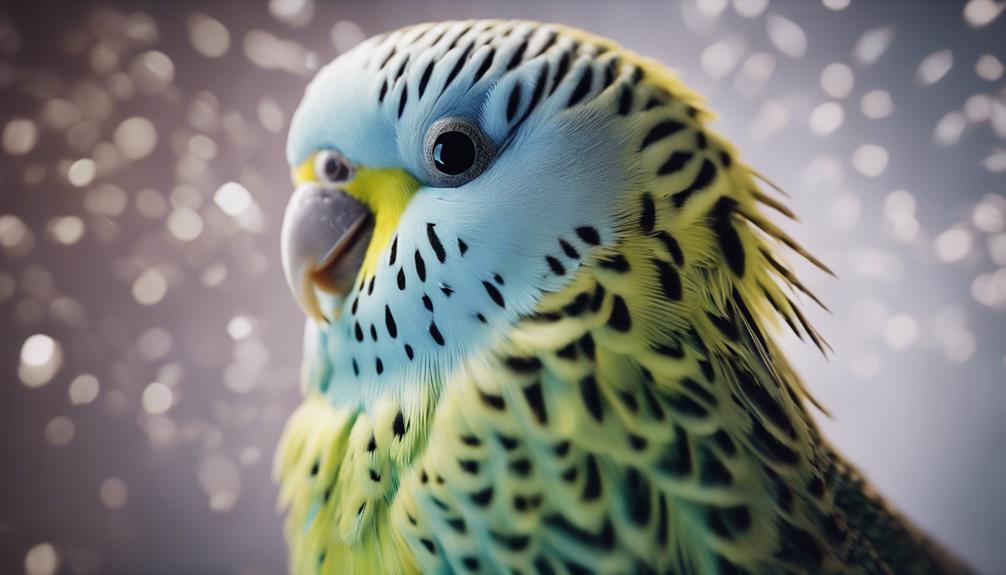
The budgerigar’s tail comprises long, slender feathers that play a crucial role in balance and maneuverability during flight. Tail feathering in budgerigars is distinctive, with the tail length being proportionate to the bird’s body size. These feathers are essential for steering and stability during flight, aiding the budgerigar in swift and precise aerial movements.
When examining a budgerigar’s tail, one may notice a variety of tail feather colors and markings. These colors can range from vibrant blues, greens, and yellows to subtler greys and whites, depending on the bird’s specific color mutation. Tail markings such as stripes, spots, or patterns may also be present, adding to the uniqueness of each budgerigar’s tail structure.
Notable Budgerigar Eye Traits
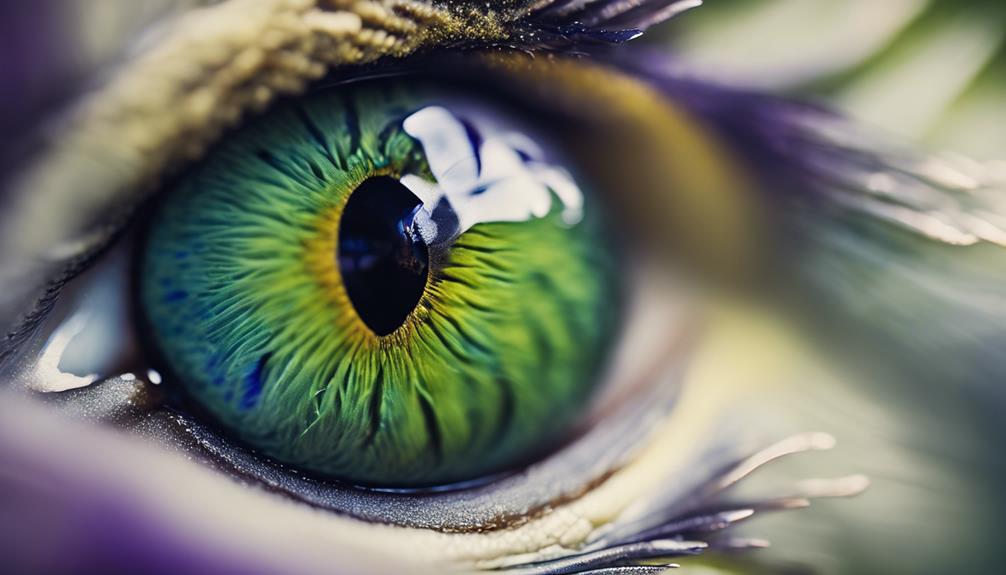
Noteworthy in budgerigars are their distinctive eye traits, showcasing a range of colors and unique features that contribute to their overall appearance and communication abilities. Budgerigars exhibit fascinating characteristics in their eyes that are essential to understanding their behavior and health:
- Eye Coloration: Budgerigars can have a variety of eye colors, including dark brown, black, or red. The color intensity can vary based on the bird’s age and genetics.
- Pupil Size: The pupils of budgerigars are small and round, allowing them to control the amount of light entering their eyes effectively.
- Eye Ring: Budgerigars have a thin, white ring around their eyes, which adds a distinctive contrast to their colorful feathers.
- Iris Markings: Some budgerigars display intricate patterns or markings on their iris, enhancing the uniqueness of each bird.
- Communication Significance: Changes in eye coloration or pupil size can indicate the bird’s emotional state, helping owners understand their budgerigar’s needs and feelings more accurately.
Frequently Asked Questions
Can Budgerigars Be Bred to Have Specific Color Patterns or Markings?
When breeding budgerigars, it is possible to develop specific color patterns and markings through selective breeding techniques. Genetic variations play a crucial role in producing desired color mutations and marking patterns in budgies.
Are There Any Specific Behaviors or Vocalizations That Are Unique to Budgerigars?
Budgerigars exhibit unique behavioral cues such as head bobbing, wing flapping, and mirror play. Their vocalizations include chattering, mimicry, and contact calls. Understanding these distinct behaviors and vocalizations can help identify and appreciate budgerigars.
How Long Do Budgerigars Typically Live in Captivity?
In captivity, budgerigars typically live 5 to 10 years. Their lifespan is influenced by diet requirements and living conditions. Providing a balanced diet and a stress-free environment can contribute to a longer and healthier life for these colorful birds.
Do Budgerigars Have Any Unique Adaptations That Help Them Survive in the Wild?
Budgerigars have evolved unique wing structures that enable swift flight, aiding in evading predators and foraging efficiently. Their specialized feeding habits, including a diverse diet of seeds and vegetation, contribute to their survival in the wild.
Are There Any Health Concerns or Common Illnesses That Budgerigars Are Prone To?
Common illnesses affect budgerigars, including respiratory infections, mites, and fatty liver disease. Preventative measures like regular vet check-ups, a balanced diet, and a clean environment can help maintain budgies’ health and well-being.



